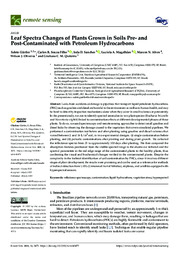Leaf Spectra Changes of Plants Grown in Soils Pre- and Post-Contaminated with Petroleum Hydrocarbons.
Leaf Spectra Changes of Plants Grown in Soils Pre- and Post-Contaminated with Petroleum Hydrocarbons.
Author(s): GÜRTLER, S.; SOUZA FILHO, C. R.; SANCHES, I. D.; MAGALHÃES, L. A.; ALVES, M. N.; OLIVEIRA, W. J.; QUITÉRIO, G. C. M.
Summary: ABSTRACT: Leaks from accidents or damage to pipelines that transport liquid petroleum hydrocarbons (PHC) such as gasoline and diesel are harmful to the environment as well as to human health, and may be hard to detect by inspection mechanisms alone when they occur in small volumes or persistently. In the present study, we aim to identify spectral anomalies in two plant species (Brachiaria brizantha and Neonotonia wightii) linked to contamination effects at different developmental phases of these plants. To do so, we used spectroscopy and remote sensing approaches to detect small gasoline and diesel leaks by observing the damage caused to the vegetation that covers simulated pipelines. We performed a contamination test before and after planting using gasoline and diesel volumes that varied between 2 and 16 L/m3 soil, in two experimental designs: (i) single contamination before planting, and (ii) periodic contaminations after planting and during plant growth. We collected the reflectance spectra from 35 to approximately 100 days after planting. We then compared the absorption features positioned from the visible spectral range to the shortwave infrared and the spectral parameters in the red edge range of the contaminated plants to the healthy plants, thus confirming the visual and biochemical changes verified in the contaminated plants. Despite the complexity in the indirect identification of soil contamination by PHCs, since it involves different stages of plant development, the results were promising and can be used as a reference for methods of indirect detection from UAVs (Unmanned Aerial Vehicles), airplanes, and satellites equipped with hyperspectral sensors.
Publication year: 2022
Types of publication: Journal article
Unit: Embrapa Territorial
Observation
Some of Embrapa's publications are published as ePub files. To read them, use or download one of the following free software options to your computer or mobile device. Android: Google Play Books; IOS: iBooks; Windows and Linux: Calibre.
Access other publications
Access the Agricultural Research Database (BDPA) to consult Embrapa's full library collection and records.
Visit Embrapa Bookstore to purchase books and other publications sold by Embrapa.

